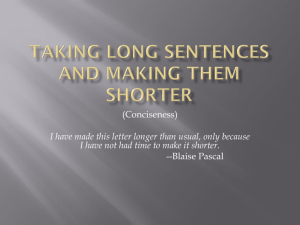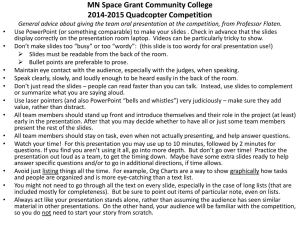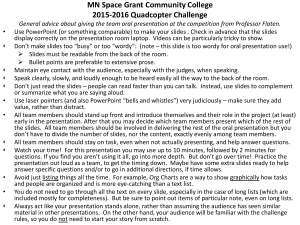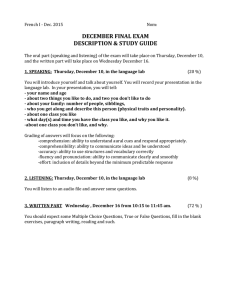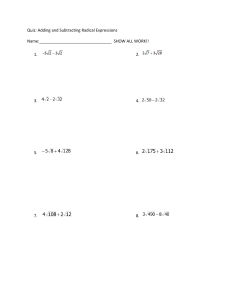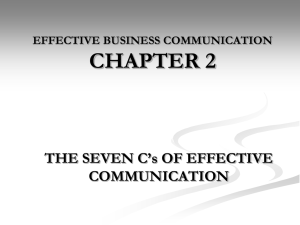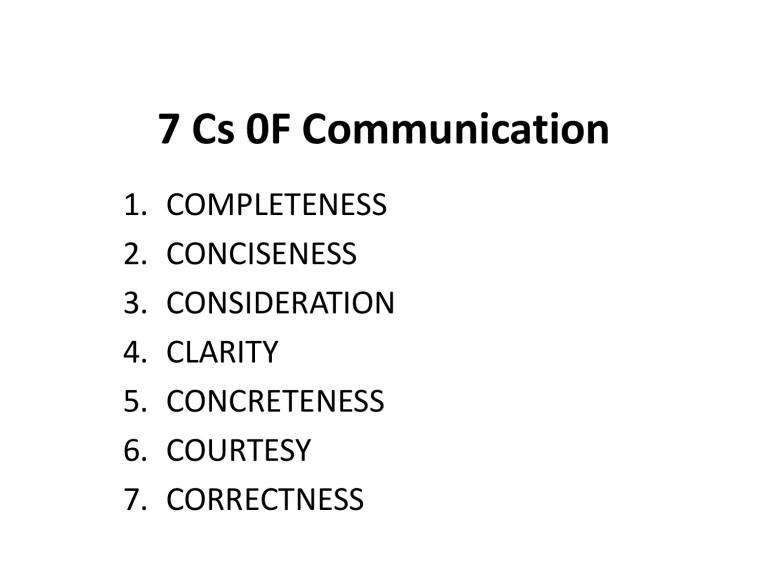
7 Cs 0F Communication 1. 2. 3. 4. 5. 6. 7. COMPLETENESS CONCISENESS CONSIDERATION CLARITY CONCRETENESS COURTESY CORRECTNESS COMPLETENESS • Contains all facts the reader or listener needs for the reaction you desire. • For completeness Provide all necessary information Answer all questions asked Give something extra when desirable (use judgment) Check for five Ws & one H – – – – – – Who What When Where Why How Exercise-1 • You are the president of an industry association and have received the following inquiry from an out of town member: “I think I would like to attend my first meeting of the association, even though I am not acquainted with your city. Will you please tell me where the next meeting is being held?” • How would you reply to this letter keeping in mind Completeness of the message? CONCISENESS 1. Eliminate wordy expressions 2. Include only relevant statements – be focused – Shorten & avoid long explanations – avoid gushing politeness 3. Avoid unnecessary repetitions – use short forms the second time – use pronouns Eliminate Wordy Expressions • Use single words in place of phrases. • Use simple, one syllable words. Wordy: at this time Concise: now Wordy: Due to the fact that Concise: because Exercise • Eliminate wordiness. Due to the fact that Employed the use of Basic fundamentals Completely eliminate Alternative choices Actual experience Connected together Final result Prove conclusively In as few words as possible Include Only Relevant Material Wordy: We hereby wish to let you know that our company is pleased with the confidence you have respond in us. Concise: We appreciate your confidence. • Find single word substitutes for the phrases. With regard to Despite the fact that At the present Is of opinion that In the first place At a rapid rate about although now thinks first fast Exercise • Rewrite the following by omitting articles, trite (worn out) expressions, wordy sentences and repetitions: At this time I am writing to you to enclose the post paid appointment for the purpose of arranging a convenient time when we might gettogether for a personal interview. CONSIDERATION • Prepare every message with the receivers in mind • Try to put yourself in their place. • Do not lose your temper • Do not accuse and charge without facts. • Thoughtful consideration or “you-attitude”. Be Considerate • Focus on YOU instead of I & WE • Show reader benefit & interest – meet recipient's needs – address their concerns, or – offer them rewards • Emphasize on positive & pleasant • Apply integrity & ethics Exercise • Write with a ‘you ‘ attitude. I want to send my congratulations for -(Congratulations to you….) We will ship soon the goods of your orderWe pay eight percent interest on ----- • Avoid negative – unpleasant words. It is impossible to open an account for you today. When you travel on company expense, you will not receive approval for first class fare. • Show reader’s benefit Because we have not written to you in sometime , please help us bring our record by filling and returning the other half of the card. CLARITY • Getting the meaning from your head to the head of your reader accurately. I. Choose precise, concrete & familiar words Use familiar, short words. Use synonyms of Latin terms. Be observant when using technical terms. Use e mail acronyms carefully. Use simple words • • • • • Subsequent Accede Endeavour Supersede Disclose later agree try replace show II. Construct effective sentences & paragraphs. Length (17-20 words) Unity (one main idea) Coherence (correct arrangement) His report was about managers, broken down by age & gender. Better: His report about managers focused on … Emphasis (main idea up front, use visual innovation) The airplane finally approached the speed of sound, and it became very difficult to control. Better: As it finally approached the speed of sound, the airplane became very difficult to control. Exercise • Candidates should be motivated and have interest in static & dynamic testing of material & have those prerequisites and others. (rewrite for better emphasis) • After our perusal of pertinent data, the conclusion is that a lucrative market exists for the subject property. (unfamiliar) • Being an excellent lawyer, I am sure you can help us. (make it clear) CONCRETENESS • Be specific, definite, and vivid. • Do not be vague and general. • Use donatives (direct, explicit, often dictionary based) rather than connotative words (ideas or notions suggested by or associated with a word or phrase) How to Apply Concreteness • Use specific facts and figures • Put action into words • Choose vivid image building words by comparison & figurative language • Use more adjectives and adverbs • Use Specific Facts & Figures Use exact, precise statement or a figure in place of a general word. Some exceptions When specific figures or facts are not present. When you wish to be diplomatic (considerate). When exact figures are unimportant. • Put Action into Words Use the Active Voice Put Action in your Verbs rather than in nouns & infinitives Use the Active voice Subject performs the action (gives life) Active verb makes your sentence more i. Specific (dean decided v/s a decision is made) ii. Personal (you will note v/s it will be noted) iii. Concise (figure shows v/s it is shown by figures) iv. Emphatic (the students held a contest v/s a contest was …) Prefer Passive Voice • To avoid personal, blunt accusations or comments The October check was not included v/s you failed to include • When you want to stress the object of the action. You are invited v/s we invite you. • When the doer isn’t important in the sentence. Three announcements were made before the meeting started. Put Action in Verbs, not in Nouns Seven deadly verbs- be, give, have, hold, make, put & take. Action hiding in a Quiet nounAction in verbs Collection collect, held the meeting met Put Action in Verbs, not in Infinitives To check check, to keep keep • Choose Vivid, Image-Building Words Use sensory appeal, comparisons, figurative language, concrete nouns & well chosen adjectives Use fewer description • Sensory Appeal Concrete language often evokes sensory response. • Comparison Make an unclear idea clear or vivid. • Figurative Language Use figures of speech sparingly. Exercise for Concreteness • Student scores are higher. (use figures) • The tests were administered by the professor. (use active voice) • Professor H. will give consideration to the report. (put action in verbs, not in noun) • This is a long letter. (use comparison) COURTESY • Be aware of perspective & feelings of audience. • Politeness out of respect & concern (please/ thank you) • Generate courteous tone Be sincere, tactful, thoughtful and appreciative Use expressions that show respect Omit expressions that hurt , irritate, or insult Choose nondiscriminatory expressions Be sincere, tactful, thoughtful and appreciative Letter requires more niceties than e mail. Stupid letter; I can’t understand any of it. It’s my understanding … Cordial messages build goodwill. Use expressions that show respect. I do not agree with you Obviously you overlooked Your failure to Your stubborn silence Omit Questionable humor Hey man, what’s this I heard about the good news? You didn’t tell any of us about it. Give my regards to the little lady and wish her the best; she’ll need it. Choose nondiscriminatory expressions • • • • Gender language “Man” words Avoid ‘he, his, him’ for hypothetical person Use names treating each gender with respect, in parallel form Ted Aprill & Ruth Ted & Ruth Aprill • Use of miss, Mrs. or Ms. Sexist Terms: “Man” words • • • • Freshman New student, Entering student Manpower Workers, Employees Man-made Constructed, Manufactured, Built Chairman Chairperson, Chair Singular pronouns • Anyone who comes to the class late will get his grade reduced. • Each manager has an assigned parking place. He should park his car………. Exercise for Courtesy • Your letter is not clear at all. • Obviously, if you would read your policy carefully you will be able to answer these questions yourself. (Avoid Blunt Language) • The best man for the job • Salesman (avoid gender language) Activity • Bring courtesy in the following text: Hey man, what’s this I hear about the good news? You sure pulled a fast one this past weekend-and then didn’t tell any of us about it. Give my regards to the little lady. And wish her the best; she’ll need it. More courteous Warm congratulations on your wedding! Well, you certainly took us by surprise. In fact, just a few of us even suspected you were taking off to get married. But even though we did not hear about it, we wish you the best. Give our warm regards to your new partner. CORRECTNESS • • • • Proper grammar, punctuation, & spellings Use the right level of language Check accuracy of facts, figures and words Maintain acceptable writing mechanics Use the Right Level of Language • Three levels of language i. Formal (scholarly writing) ii. Informal (business writing) iii. Substandard Formal Unconversational Impersonal Long sentences Informal Conversational Well known Short Formal and Less Formal Language • Formal informal Participate join Endeavour try Deem think Utilize use Interrogate question Avoid substandard language Incorrect words, grammar Faulty pronunciation Aim at proving aim to prove Can’t hardly can hardly Maintain Acceptable Writing Mechanics • Appearance of business letter Check Accuracy of Figures, Facts, and Words • Verify your statistical data • Double-check your totals • Have someone else read your message if the topic involves data • Determine whether a fact has changed over time Few tips for effective verbal messages • Be direct • Consider your audience • Be clear • • • • • Watch your non-verbal signals Pay attention to the receivers Repeat when needed Communicate bit by bit Use varying techniques

